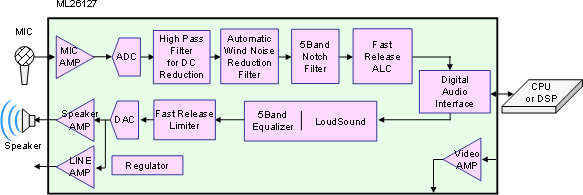2010 News Release
December 8, 2010
Industry’s First Audio Codec With Built-In Automatic Wind Noise Reduction Filter
OKI Semiconductor has recently announced the development of the industry’s first 16bit monaural audio codec IC with a built-in automatic wind noise reduction filter, designed to improve audio recording by minimizing wind noises during microphone recording.
The ML26127 was developed to meet the growing need for improved sound quality in portable devices with recording capability, particularly against the introduction of wind noise, which makes high-fidelity audio reproduction virtually impossible when using a microphone.
Existing audio codec ICs typically filter out certain low-frequency bands in order to reduce wind noise. However, this eliminates other low-frequency sounds as well, reducing overall sound quality. In response to this, OKI Semiconductor included an automatic wind noise reduction filter that automatically detects wind noise and adaptively changes the filtering level for optimum recording and playback. In addition, a fast release ALC function is included, along with multiple noise reduction circuits and proprietary LoudSound technology that enables louder output from small speakers. The product is available in a compact W-CSP form factor measuring only 2.46mm×2.46mm,t=0.4mm), making it ideal for portable devices of all types.
- Pricing: 500yen
- Availability: Now (Samples)/March 2011 (OEM Quantities)
Key Features
- Integrated automatic wind-noise reduction filter
- Fast release ALC (Automatic Level Controller) function built in for fast sound level control
- Built-in LoudSound function for louder sound reproduction in small speakers (1.5-2×)
- Stable audio recording/reproduction, even under severe power source conditions
- 5-band notch filter removes capacitor-generated frequencies for improved noise reduction
- Unique algorithm ensures high-speed startup and pop noise reduction
- Ultra-compact package
Block Diagram

Product Comparison
| ML26127HB <New> |
ML26125HB <Conventional> |
ML26124-01HB <Conventional> |
ML26121AHB <Conventional> |
|
| Microphone Input | Monaural | Monaural | Monaural | Stereo |
| Codec | Monaural | Monaural | Monaural | Stereo |
| On-chip Regulator | Yes | Yes | Yes | – |
| Video Amp Gain | 6,9,12dB | 6,9,12dB | 6,9,12dB | – |
| Video Amp Input Impedance | 75Ω to 300Ω | 75Ω to 300Ω | 75Ω to 300Ω | - |
| Speaker Amp | Monaural | Monaural | Monaural | Monaural |
| Line Amp | Yes (Pop noise reduction function) |
Yes (Pop noise reduction function) |
Yes | Yes |
| Fast Release ALC | Yes | – | – | – |
| Wind-Noise Reduction Filter | Yes | – | – | – |
| Recording Motch Filter | 5-band | 5-band | 5-band | 5-band |
| Playback Equalizer | 5-band | 5-band | 5-band | 5-band |
| LoudSound | Yes | Yes | – | Yes |
Terminology
- WL-CSP (Wafer Level Chip Size Package)
- An ultra-compact package featuring roughly the same external dimensions as the chip itself.
- PSRR (Power Supply Rejection Ratio)
- This indicates the amount of noise from a power supply a particular device can reject. The larger the value, the more stable the output is against power source voltage fluctuations.
- Notch Filter
- A filter that removes noise by attenuating specific frequencies.
- Regulator
- Used to remove noise superposition of specific frequencies during recording.
- THD (Total Harmonic Distortion)
- Indicates the amount of (harmonic) distortion present, and is defined by the ratio of the sum of the powers of all harmonic components to the power of the fundamental frequency. Often expressed in dB.
Contact
For customers' inquiry regarding this release: please go to ![]() the inquiry page
the inquiry page
* Information in the press releases is current on the date of the press announcement, but is subject to change without prior notice.
*Please note that the names of companies and products described in this document are the trademarks or registered trademarks
of their respective companies and organizations.


